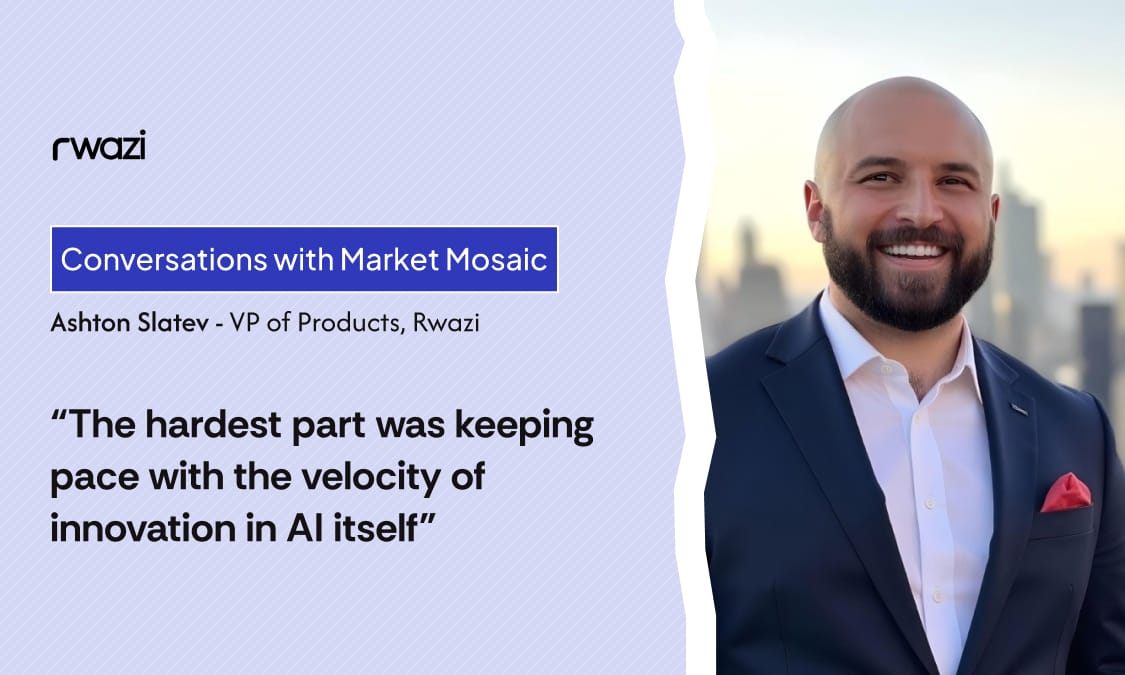MEET OUR INDUSTRY GUEST
Ashton Slatev, VP of Product at Rwazi
In our inaugural "Conversations with Market Mosaic" series, we sit down with this product leader and innovator who has built AI-powered products across healthcare, supply chain, and market intelligence.
In this week's conversation, Ashton shares fascinating insights on how the smartest teams are moving beyond static consumer insights to build continuous feedback loops that adapt in real-time.
Enjoy the full interview below!

Photo: Ashton Slatev speaking on "Pioneering the New Era with AI" at MIT
Market Mosaic: You have built products at Epic (healthcare), Scoutbee (supply chain), and now Rwazi (market intelligence) - that's quite a journey. What's one surprising insight about understanding markets and consumer behavior that transferred across these three industries?
Ashton Slatev: First, the real world is always messier than your model.
Across every industry, the biggest surprise was how often the "truth" on the ground diverged from what the data or dashboards suggested. At Epic, patient records showed perfect medication adherence — until we asked nurses and learned about the delays and workarounds. At Scoutbee, procurement pipelines looked smooth until you accounted for last-mile delivery chaos. And now at Rwazi, we constantly see the gap between what brands think is happening and what consumers are actually doing. The common thread? You can't shortcut real-world context. That's why hyper-local, on-the-ground data matters more than ever.
Second, people shape every system, even the most technical ones.
It’s easy to get lost in systems, workflows, and data pipelines, but what I have found most surprising is how much success in every industry comes down to human behavior. Whether it’s a clinician overriding a care pathway, a supply chain team making an off-book decision to prevent a delay, or a consumer choosing a local brand over a global one because of cultural relevance, people bend systems to fit their context. The lesson? Products need to flex with real human decisions, not just optimize for the ideal flow.
Third, data is never enough—context is the multiplier.
Whether you're dealing with patient outcomes, supplier reliability, or consumer trends, raw data on its own rarely tells the full story. What's consistently transferred across industries is the need to layer in environmental context—what's happening around the person or business—to extract real insight. That’s the principle that drives a lot of our AI work at Rwazi: combining hard data with the nuance of local behavior and sentiment.
Across every industry, the biggest surprise was how often the "truth" on the ground diverged from what the data or dashboards suggested.
Market Mosaic: You have been with Rwazi for over 2 years, from the founding Product Manager to VP of Product. What's been the most challenging aspect of building AI-powered market intelligence products, and how did you overcome it?
Ashton Slatev: The hardest part was keeping pace with the velocity of innovation in AI itself. Every few weeks, a new model would launch with groundbreaking capabilities, and our team felt the pressure to vet each one and decide if it should power our platform.
What changed everything was a shift in mindset: we stopped chasing a single ‘best’ model and instead broke down our product pipeline into discrete tasks: data extraction, summarization, validation, etc.—and matched each to the AI models best suited for it.
That move toward modular specialization unlocked a step-change in both performance and reliability. We were early in building an agentic AI platform, and it's allowed us to stay adaptable, ship faster, and deliver more precise value to our customers.
What changed everything was a shift in mindset.
Market Mosaic: If a product or brand manager has just 30 minutes with you to better understand how to leverage AI for consumer or user insights across different international markets, what's the one thing you would tell them to do that most of their competitors aren't doing?
Ashton Slatev: Short answer: Use Rwazi 😄
Long answer: Most teams treat consumer insights as a one-time input—something you gather at the beginning of a campaign or product cycle. But in a world that’s moving this fast, the real edge comes from building a continuous feedback loop between consumers and your product strategy.
The smartest teams are using AI to not just analyze static datasets, but to dynamically identify gaps in their understanding and trigger new data collection in real time. That shift—from passively analyzing what's already there to actively closing knowledge gaps as they emerge—is what separates reactive teams from truly adaptive ones. It’s how we’ve built Rwazi to operate, and it’s where the industry is headed.
The real edge comes from building a continuous feedback loop between consumers and your product strategy.
▶ Know someone who’d love this insightful conversation? Please share it their way.
▶ Also want to feature in our next expert interview edition? Let us know here
